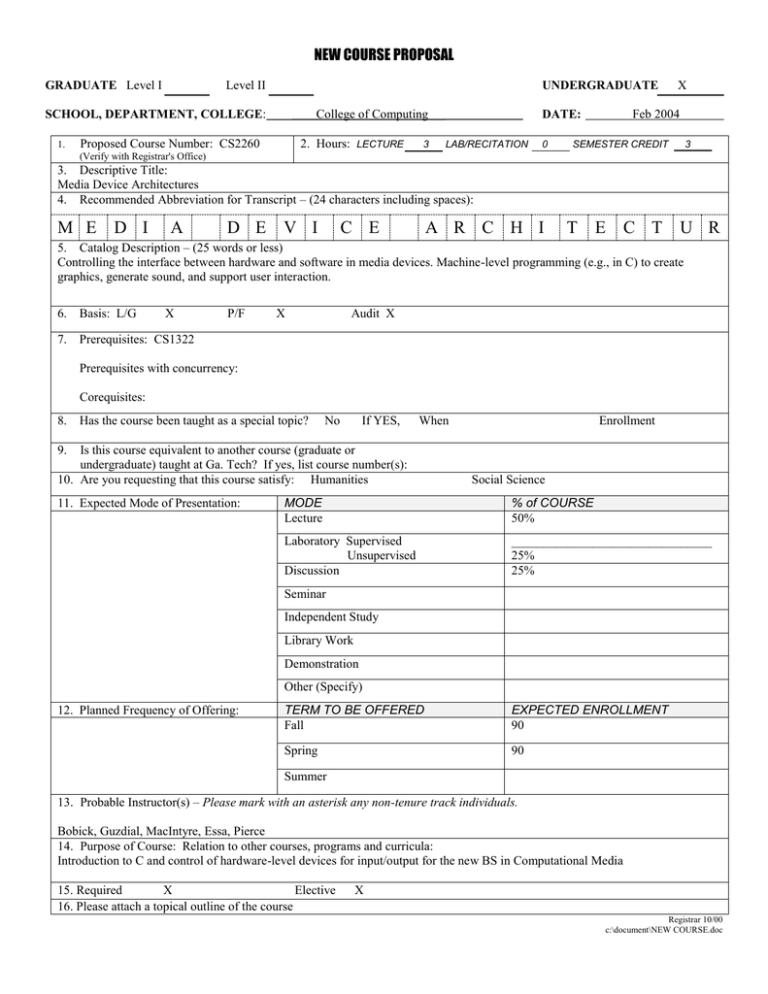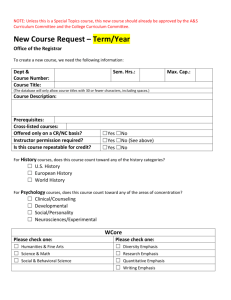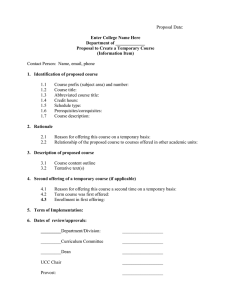NEW COURSE PROPOSAL
advertisement

NEW COURSE PROPOSAL GRADUATE Level I Level II UNDERGRADUATE SCHOOL, DEPARTMENT, COLLEGE: 1. College of Computing Proposed Course Number: CS2260 2. Hours: LECTURE 3 DATE: LAB/RECITATION 0 X Feb 2004 SEMESTER CREDIT 3 (Verify with Registrar's Office) 3. Descriptive Title: Media Device Architectures 4. Recommended Abbreviation for Transcript – (24 characters including spaces): M E D I A D E V I C E A R C H I T E C T U R 5. Catalog Description – (25 words or less) Controlling the interface between hardware and software in media devices. Machine-level programming (e.g., in C) to create graphics, generate sound, and support user interaction. 6. Basis: L/G X P/F X Audit X 7. Prerequisites: CS1322 Prerequisites with concurrency: Corequisites: 8. Has the course been taught as a special topic? No If YES, When Is this course equivalent to another course (graduate or undergraduate) taught at Ga. Tech? If yes, list course number(s): 10. Are you requesting that this course satisfy: Humanities Enrollment 9. 11. Expected Mode of Presentation: Social Science MODE Lecture % of COURSE 50% Laboratory Supervised Unsupervised Discussion ________________________________ 25% 25% Seminar Independent Study Library Work Demonstration Other (Specify) 12. Planned Frequency of Offering: TERM TO BE OFFERED Fall EXPECTED ENROLLMENT 90 Spring 90 Summer 13. Probable Instructor(s) – Please mark with an asterisk any non-tenure track individuals. Bobick, Guzdial, MacIntyre, Essa, Pierce 14. Purpose of Course: Relation to other courses, programs and curricula: Introduction to C and control of hardware-level devices for input/output for the new BS in Computational Media 15. Required X Elective 16. Please attach a topical outline of the course X Registrar 10/00 c:\document\NEW COURSE.doc Learning Objectives 1. To understand the structure and operation of modern media devices 2. To understand basic hardware concepts: digital circuits, gates, bits, bytes, number representation, memory structure, and memory addresses. 3. To understand be able to control the structure and function of input/output devices. Understand how I/O devices interface to the computer, including memory-mapped I/O and port I/O. 4. To be able to write programs to control pixels in a display and sounds from a speaker, and read simple input devices such as keyboards. To understand the basic software control of more sophisticated I/O devices such as network adapters and disk drives. 5. Basic concepts of computer systems such as the runtime stack, user/supervisory state, and memory management 6. Introduce the C language with particular emphasis on the underlying assembly and machine language as well as interaction with hardware. Course Outline and Syllabus 1. 2. 3. 4. 5. 6. 7. 8. 9. 10. 11. 12. 13. 14. 15. Course introduction and overview: Why we care about controlling devices at the lowest level Bits, Data Types, and What Computers can Do with Them Digital Logic Structures. How computation arises from AND, OR, and NOT. The Von Neumann Model—parts of a computer Introduction to Programming in C: Basic operators Control Structures and functions Variables and data types, and how these map to memory Data structures in C: Arrays and strings, pointers, and structs Debugging in C: Understanding what’s happening at the C level and lower. How input is handled in the computer: Interrupts, polling. How output is handled in the computer: Memory-mapped devices, ports. What an operating system buys you, and how to keep users out of the operating system, e.g., traps. How to make that bit right there turn red. Representations of color, and mapping color to devices. How to make characters appear. Bit-mapped vs. algorithmic character definitions (Truetype, Postscript) How to make sound reach our ears: D/A conversion Representations of sound in memory. Getting the user’s input: Reading a keyboard/keypad. Textbooks 1. Introduction to Computing Systems : from bits and gates to C and beyond by Yale Patt and Sanjay Patel

